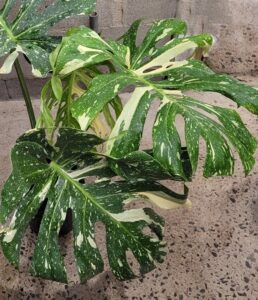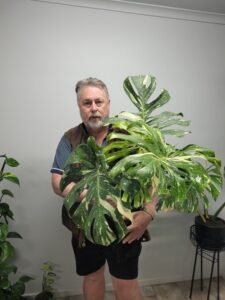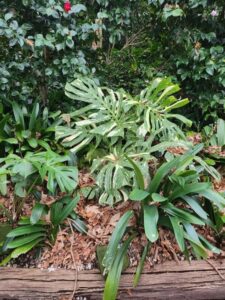
Monstera deliciosa ‘Thai Constellation’
By Clive Larkman
Monstera ‘Thai Constellation’ took the world by storm in the mid to post COVID years. At the time, indoor plants were undergoing a resurgence that started just pre-COVID and then went ballistic as we were all shut down. The millennials suddenly found the pleasure of filling the home with large, leafy plants and that there were many rare cultivars coming onto the market. Australia has strict quarantine laws which makes it very hard to import live plants, and the laws are getting tougher and people importing are fewer.

Let’s go back 50 years to Thailand when the attractive plant Monstera deliciosa, from Mexico and Central America, arrived in the Thai plant industry. It also arrived in Australia in the 1960’s/1970’s as the Swiss Cheese plant. Sometime in the next decade or two, a cream variegated form turned up. This is quite common in plants that are in mass production. Sometimes the mutation doesn’t get noticed, or if it does, then it cannot be stabilised for mass production. Other times they become a ‘must have’ plant for keen collectors and avid gardeners.
There is a lot of conjecture about the origin, and it is hard to pick out truth from myth. There is a series of articles saying it was genetically created in a laboratory around 2000. There are others that say this happened around 2010. Both theories are a bit fanciful to try and give the plant more mystique. There are numerous cases of large indoor plants having naturally occurring variegations from all over the world without genetic interference by man. My wife Di and I saw a large plant in a public garden in 2015 in the USA which was too large to have been ‘bred in Thailand’ post 2010.
The most likely story is that the plant occurred in the mid to late 1980’s, and as variegated plants were not particularly popular at the time, it was ignored. Variegated plants have been around for over one hundred years and are natural mutations. Due to their lower chlorophyll content, they don’t normally survive without man taking cuttings and asexually propagating them for mass production. So, if there is no demand many variegated plants get lost. During the 1990’s, with the advent of PVR (PBR) and advanced label production, producers were able to protect and market new plants. This meant that variegated plants became quite popular with the wider gardening community. Growers could afford to invest in new plants and were able to market them.
In 2018 Kathryn Barnett imported 42 plants of the ‘new’ monstera called ‘Thai Constellation’. There is no apparent record of anyone importing them prior to that year. These plants were small to large, and the latter were mature plants with the large fenestrations that only occur in mature plants. Seedlings and plants from tissue culture generally take at least five years to produce mature foliage and then another few years to flower. Most of her plants were small and didn’t survive the fumigation and post entry quarantine. A few did and she gave me one nearly dead cutting from a mature plant.

I was able to keep this plant alive and eventually grow it on. That plant is now two metres long with foliage that is 60-80cm in diameter, has large fenestrations, great balance of variegation, and is producing cream and variegated flowers and fruit. Kathryn’s plants were either cuttings from cuttings from the original plants, or cuttings from mature tissue culture. The latter is less likely to be correct as the whole process of tissue culture is less than twenty years old as a commercial option.
Tissue culture plants in sterile agar containers are not required to go through post entry quarantine. They are 100% inspected and then released. This quickens the import process but slows down the growing as it takes around five years to show maturity. Even then it doesn’t have the presence of an original plant. Sometime around 2023 the tissue cultured plants arrived in Australia and the market was quickly flooded with them. They are attractive plants but are nowhere near as stunning as mature plants from the early cutting-grown individuals.
‘Thai Constellation’ has deep green foliage with star like cream spots and large blotches of white/cream. The leaves rarely show all green or all cream which separates it from most of the other variegated aroids. The plants that are cuttings from my original plant will show the mature foliage from the start. The large, fully fenestrated foliage is quick to appear. If grown well, they will flower and fruit within a year or so. The fruit takes two years to ripen on the green form in warm climates. It is unlikely to ripen south of Queensland and the variegated form is even less likely to ripen, even in the tropics.
The plant is much tougher than expected. It is most susceptible to over watering, direct summer sun or hard frost. All of these will produce yellow foliage; sun and frost will burn the top leaves, and over-watering will cause dark yellow discolouration on the old leaves. Once established in a sheltered position it will grow well outdoors in most city suburbs in Australia. The frost will cause damage, but the plant will tolerate temperatures down to 2⁰C if placed near a warm wall etc. The mature plants make a statement in the garden, on the verandah or indoors. If grown in the right position they will revert to their wild habit and grow up trees or any form of trellising that is protected from the cold weather.
